Shuo Ye
HRR: Hierarchical Retrospection Refinement for Generated Image Detection
Feb 25, 2025



Abstract:Generative artificial intelligence holds significant potential for abuse, and generative image detection has become a key focus of research. However, existing methods primarily focused on detecting a specific generative model and emphasizing the localization of synthetic regions, while neglecting the interference caused by image size and style on model learning. Our goal is to reach a fundamental conclusion: Is the image real or generated? To this end, we propose a diffusion model-based generative image detection framework termed Hierarchical Retrospection Refinement~(HRR). It designs a multi-scale style retrospection module that encourages the model to generate detailed and realistic multi-scale representations, while alleviating the learning biases introduced by dataset styles and generative models. Additionally, based on the principle of correntropy sparse additive machine, a feature refinement module is designed to reduce the impact of redundant features on learning and capture the intrinsic structure and patterns of the data, thereby improving the model's generalization ability. Extensive experiments demonstrate the HRR framework consistently delivers significant performance improvements, outperforming state-of-the-art methods in generated image detection task.
Toward Realistic Camouflaged Object Detection: Benchmarks and Method
Jan 13, 2025



Abstract:Camouflaged object detection (COD) primarily relies on semantic or instance segmentation methods. While these methods have made significant advancements in identifying the contours of camouflaged objects, they may be inefficient or cost-effective for tasks that only require the specific location of the object. Object detection algorithms offer an optimized solution for Realistic Camouflaged Object Detection (RCOD) in such cases. However, detecting camouflaged objects remains a formidable challenge due to the high degree of similarity between the features of the objects and their backgrounds. Unlike segmentation methods that perform pixel-wise comparisons to differentiate between foreground and background, object detectors omit this analysis, further aggravating the challenge. To solve this problem, we propose a camouflage-aware feature refinement (CAFR) strategy. Since camouflaged objects are not rare categories, CAFR fully utilizes a clear perception of the current object within the prior knowledge of large models to assist detectors in deeply understanding the distinctions between background and foreground. Specifically, in CAFR, we introduce the Adaptive Gradient Propagation (AGP) module that fine-tunes all feature extractor layers in large detection models to fully refine class-specific features from camouflaged contexts. We then design the Sparse Feature Refinement (SFR) module that optimizes the transformer-based feature extractor to focus primarily on capturing class-specific features in camouflaged scenarios. To facilitate the assessment of RCOD tasks, we manually annotate the labels required for detection on three existing segmentation COD datasets, creating a new benchmark for RCOD tasks. Code and datasets are available at: https://github.com/zhimengXin/RCOD.
Detail Reinforcement Diffusion Model: Augmentation Fine-Grained Visual Categorization in Few-Shot Conditions
Sep 15, 2023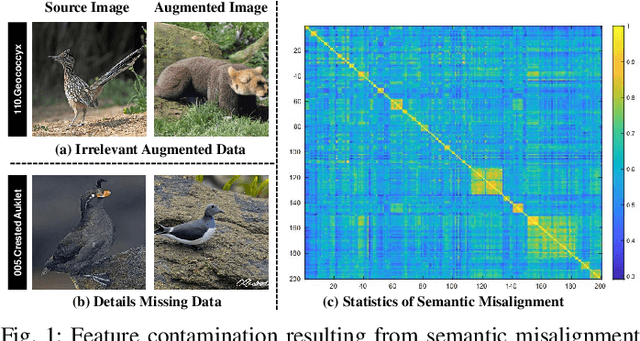
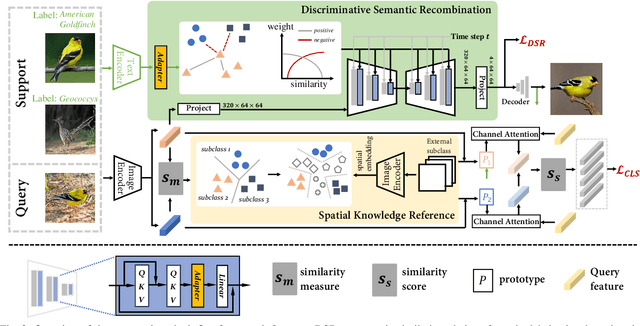
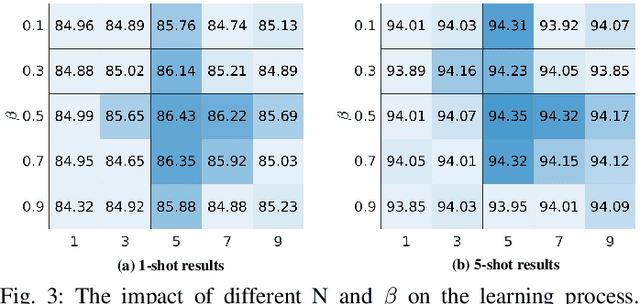
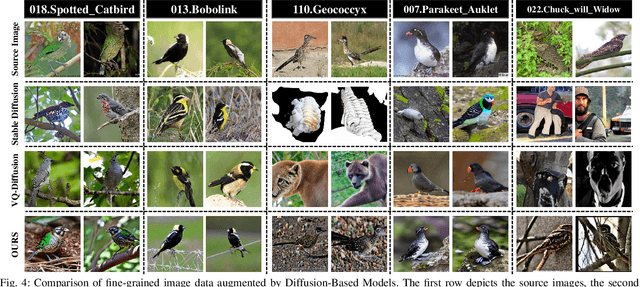
Abstract:The challenge in fine-grained visual categorization lies in how to explore the subtle differences between different subclasses and achieve accurate discrimination. Previous research has relied on large-scale annotated data and pre-trained deep models to achieve the objective. However, when only a limited amount of samples is available, similar methods may become less effective. Diffusion models have been widely adopted in data augmentation due to their outstanding diversity in data generation. However, the high level of detail required for fine-grained images makes it challenging for existing methods to be directly employed. To address this issue, we propose a novel approach termed the detail reinforcement diffusion model~(DRDM), which leverages the rich knowledge of large models for fine-grained data augmentation and comprises two key components including discriminative semantic recombination (DSR) and spatial knowledge reference~(SKR). Specifically, DSR is designed to extract implicit similarity relationships from the labels and reconstruct the semantic mapping between labels and instances, which enables better discrimination of subtle differences between different subclasses. Furthermore, we introduce the SKR module, which incorporates the distributions of different datasets as references in the feature space. This allows the SKR to aggregate the high-dimensional distribution of subclass features in few-shot FGVC tasks, thus expanding the decision boundary. Through these two critical components, we effectively utilize the knowledge from large models to address the issue of data scarcity, resulting in improved performance for fine-grained visual recognition tasks. Extensive experiments demonstrate the consistent performance gain offered by our DRDM.
Coping with Change: Learning Invariant and Minimum Sufficient Representations for Fine-Grained Visual Categorization
Jun 08, 2023Abstract:Fine-grained visual categorization (FGVC) is a challenging task due to similar visual appearances between various species. Previous studies always implicitly assume that the training and test data have the same underlying distributions, and that features extracted by modern backbone architectures remain discriminative and generalize well to unseen test data. However, we empirically justify that these conditions are not always true on benchmark datasets. To this end, we combine the merits of invariant risk minimization (IRM) and information bottleneck (IB) principle to learn invariant and minimum sufficient (IMS) representations for FGVC, such that the overall model can always discover the most succinct and consistent fine-grained features. We apply the matrix-based R{\'e}nyi's $\alpha$-order entropy to simplify and stabilize the training of IB; we also design a ``soft" environment partition scheme to make IRM applicable to FGVC task. To the best of our knowledge, we are the first to address the problem of FGVC from a generalization perspective and develop a new information-theoretic solution accordingly. Extensive experiments demonstrate the consistent performance gain offered by our IMS.
CDLT: A Dataset with Concept Drift and Long-Tailed Distribution for Fine-Grained Visual Categorization
Jun 04, 2023



Abstract:Data is the foundation for the development of computer vision, and the establishment of datasets plays an important role in advancing the techniques of fine-grained visual categorization~(FGVC). In the existing FGVC datasets used in computer vision, it is generally assumed that each collected instance has fixed characteristics and the distribution of different categories is relatively balanced. In contrast, the real world scenario reveals the fact that the characteristics of instances tend to vary with time and exhibit a long-tailed distribution. Hence, the collected datasets may mislead the optimization of the fine-grained classifiers, resulting in unpleasant performance in real applications. Starting from the real-world conditions and to promote the practical progress of fine-grained visual categorization, we present a Concept Drift and Long-Tailed Distribution dataset. Specifically, the dataset is collected by gathering 11195 images of 250 instances in different species for 47 consecutive months in their natural contexts. The collection process involves dozens of crowd workers for photographing and domain experts for labelling. Extensive baseline experiments using the state-of-the-art fine-grained classification models demonstrate the issues of concept drift and long-tailed distribution existed in the dataset, which require the attention of future researches.
R2-Trans:Fine-Grained Visual Categorization with Redundancy Reduction
Apr 21, 2022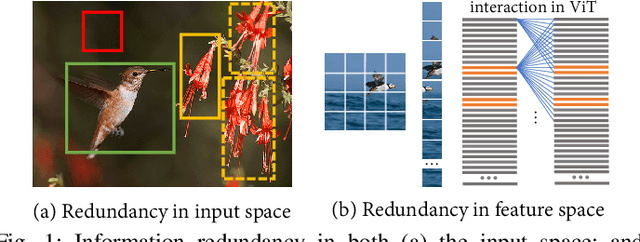
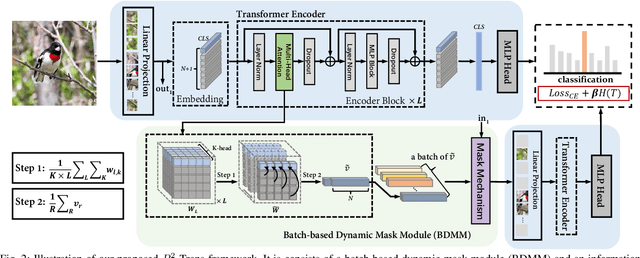
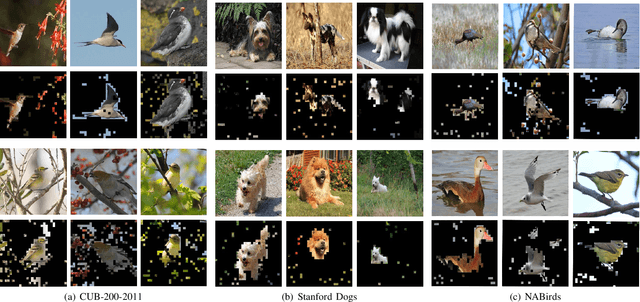
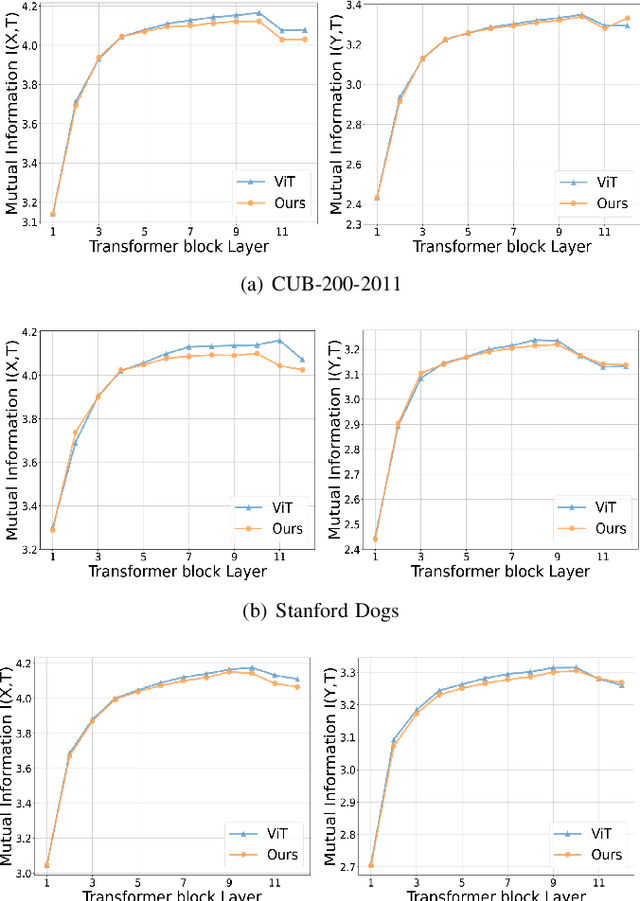
Abstract:Fine-grained visual categorization (FGVC) aims to discriminate similar subcategories, whose main challenge is the large intraclass diversities and subtle inter-class differences. Existing FGVC methods usually select discriminant regions found by a trained model, which is prone to neglect other potential discriminant information. On the other hand, the massive interactions between the sequence of image patches in ViT make the resulting class-token contain lots of redundant information, which may also impacts FGVC performance. In this paper, we present a novel approach for FGVC, which can simultaneously make use of partial yet sufficient discriminative information in environmental cues and also compress the redundant information in class-token with respect to the target. Specifically, our model calculates the ratio of high-weight regions in a batch, adaptively adjusts the masking threshold and achieves moderate extraction of background information in the input space. Moreover, we also use the Information Bottleneck~(IB) approach to guide our network to learn a minimum sufficient representations in the feature space. Experimental results on three widely-used benchmark datasets verify that our approach can achieve outperforming performance than other state-of-the-art approaches and baseline models.
 Add to Chrome
Add to Chrome Add to Firefox
Add to Firefox Add to Edge
Add to Edge